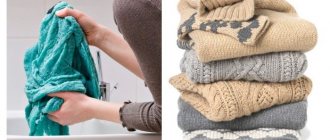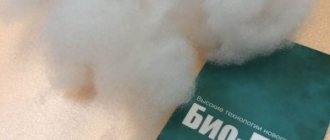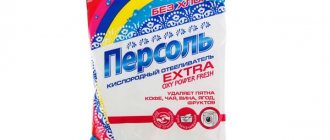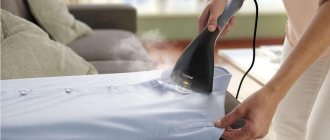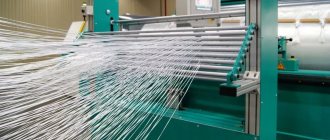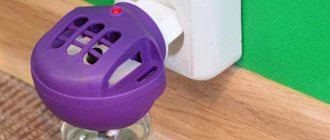Acrylic - what is this material and what does it look like?
Acrylic is a soft, modern, lightweight material made from synthetic fibers. There are other names for this fabric, for example, itron, redon, krilor or orlon. All these complex names can be combined in one word - polyacrylonitrile.
The history of acrylic began not so long ago. It was first produced by the American company DuPont in the 40s of the 20th century. The employees of this company sought to develop a new type of fiber, and by 1948 they succeeded in creating a material called Orlon. Thanks to this invention, scientists were able to slightly displace nylon, which was popular at that time. However, Orlon was difficult to dye, so the development of new fibers continued. In 1952, acrylic was born, which borrowed all the best from Orlon, and was also much easier to paint.
The composition of the fabric can vary depending on the percentage of acrylic fibers in the composition: they can be presented either in pure form or in combination with other fibers. Usually, the addition of other materials gives the fabric new positive properties, for example, increasing its service life. Acrylic fibers are added in a ratio of 100% to 5% in the production of popular materials. Thus, when creating coat fabric, acrylic is often added to wool, angora or cotton. The more natural fibers it contains, the more comfortable acrylic will be for daily wear. Mixed variations expand the scope of application of acrylic: in combination with polyester, such fabric qualities as strength and moisture resistance are increased.
Let's count the positives first
Acrylic materials have a lot of wonderful qualities:
- Unprecedented durability and evenness of paints. Here, coloring is fundamentally different from usual, when the finished canvas is simply dipped in paint. In acrylic, this process occurs during the production of fibers, when they are still in a liquid state. The thread dyed from the inside does not fade in the sun and remains pristinely bright for a long time.
- Softness and great looking products. Acrylic contains fibers similar to wool, which is why it is so pleasant to the touch, it is even called artificial wool. Low thermal conductivity. The fabric retains heat remarkably well; it is not afraid of frost down to -30°C or 50-degree heat.
- Form stability. Acrylic does not stretch: included in knitted products, it perfectly retains their shape, and in fabrics it does not sag or deform. The products do not wrinkle, they are irreplaceable in difficult conditions when you need to look fresh and neat.
- Water repellent and quick drying. Water rolls off the surface of the material; it is ideal for use outdoors, even in difficult climatic conditions. Elasticity. This quality has found wide application in acrylic in sewing sportswear.
- Resistance to living organisms. Fibers are not afraid of mold, fungi, and moths do not eat them.
- There is no shrinkage or stalling. With proper care, the products retain their size and decent appearance throughout the entire period of use, and do not stretch.
- Ability to combine with other fabrics. This is due to the special structure of acrylic. The resulting samples are distinguished by their brightness, liveliness, special tints or shimmering effect.
- Continuous thread. This quality characterizes all artificial fibers. It explains the amazing clarity of the weave pattern and smoothness. Convenience of product manufacturing. It is comfortable to work with acrylic yarn on knitting machines; as a rule, it is microacrylic.
- Fire resistance. Synthetic fabric - acrylic - does not burn, but melts.
- Safety. All fibers underwent strict sanitary and hygienic control before being put into production. They are recognized as hypoallergenic and safe, not harmful to human health.
stoit-li-boyatsya-sinteticheskih-tkaney-universalnost-lyogkogo-akrila-2
stoit-li-boyatsya-sinteticheskih-tkaney-universalnost-lyogkogo-akrila-3
Production technology
Acrylic manufacturers use natural gas as a basis, which is the key material from which acetylene (a flammable gas) and hydrocyanic acid (hydrogen cyanide solution) are extracted. Without them, the production of acrylic fibers would be impossible. The essence of creating acrylic is a complex chemical reaction.
- In production, acrylic is a continuous thread. The structure of such a finished thread allows us to achieve a completely smooth surface of the material and a clear weave pattern. This is how acrylic fibers differ from wool yarns.
To achieve a more unusual texture, such continuous synthetic fiber is cut into smaller pieces, each of which is the same size - these pieces are called staples. The material, made from staple yarn, is visually very similar to natural wool, which is why sometimes acrylic fabric is also called “artificial wool”.
Estimated cost
Compared to natural wool, acrylic products are significantly lower in price. Additionally, dense acrylic fabric can be purchased in a variety of color combinations. A thin sheet of acrylic can be purchased on average from 340 rubles per linear meter.
Acrylic fibers have long become a kind of substitute for expensive natural wool, so the areas of use are more than extensive.
The process uses different technologies to produce fabrics with different acrylic contents. The main characteristics, composition and application of acrylic fabrics are described in the information in our article. .
Material properties
Despite the fact that acrylic is not a natural material, this high-quality fabric has many features for which it is valued:
- Hypoallergenic. Synthetic clothing is often treated with prejudice precisely because of possible skin reactions. However, not everyone remembers, but it is wool that can cause allergies. And things made from acrylic are suitable for people even with sensitive skin, for example, children or allergy sufferers. This is an important characteristic of durable and very unpretentious acrylic fabric.
- Comfortable to wear, soft, delicate to the touch. Many people confuse acrylic with wool, and not surprisingly, they are similar not only in their ability to retain heat, but also in their pleasant tactile qualities.
- Wear resistance. Products made from acrylic can be dry cleaned, as these fibers are insensitive to solvents. In addition, acrylic perfectly withstands a variety of weather conditions, so when creating outerwear, craftsmen give preference to this material.
- Presentability. Acrylic does not wrinkle at all and holds its given shape well, so it retains a decent appearance even after prolonged wear. Things made from acrylic always look neat. This feature is relevant for creating an evening look, when any flaw can ruin the overall impression of the look.
- Shade durability. Of course, it all depends on the dyeing method, but most often acrylic fibers lend themselves well to dyeing and retain their color brightness for a long time, even after several washes.
Leading manufacturers
Many well-known companies use synthetics in the production of fabrics. Acrylic is found in almost every collection of both domestic and global brands. Let's highlight the most popular brands:
- "Sauleda" Spain;
- "Sattler" Austria;
- "Dikson" France;
- as well as manufacturers from the Russian Federation, the USA and China.
Acrylic fabric Austria PHOTO: centrsvet.ru
Natural fabric or not
Since acrylic resembles wool in many ways, some users mistakenly consider it natural. Acrylic is a synthetically produced fabric that is obtained through a complex chemical reaction from natural gas. The fibers of this material are strong and smooth, thanks to which professionals can create the most accurate resemblance of wool from a uniform weave. This feature allows the use of acrylic for universal sewing of warm clothes, which can be difficult to distinguish from woolen ones.
Benefits of acrylic
- Softness, comfort to wear. These properties of acrylic resemble wool.
- Heat retention. Acrylic has low thermal conductivity, so these products will keep you warm even in the cold season.
- There is no risk of exposure to dust mites or moths.
- High color and print fastness. Acrylic fibers lend themselves well to dyeing, and the brightness of the shades is maintained even after numerous washes.
- After interacting with moisture, for example, during washing, acrylic products dry quickly, do not lose shape, do not stretch or wear out, even when exposed to various chemicals.
Disadvantages of acrylic fabric
- Acrylic has many positive qualities, but one cannot fail to mention its disadvantages, which can be an important factor in the purchasing decision.
- The fabric becomes highly electrified when worn or dried at high temperatures. This problem can be solved by using antistatic sprays.
- If you let an acrylic item dry for too long, it can become too hard and unpleasant to the touch. The same applies to long exposure to the open sun: acrylic loses its characteristic softness and tenderness under the influence of light. Therefore, be careful when caring for acrylic; it is better to avoid purchasing this material for sewing children's wardrobes.
- Prolonged wear may cause pilling to appear on the surface of the fabric.
- Low air exchange. You will be warm in an acrylic product, but due to poor air exchange rates, sweating may increase.
- It is difficult to remove greasy stains from acrylic fabric, as they are especially easily absorbed into the fibers.
FAQ
Not all buyers can identify the fabric at first glance, which is why many have some questions. We will answer the most popular ones, for example, acrylic is a synthetic or natural material.
Acrylic fabric – is it synthetic or not?
Consumers should be aware that 100% acrylic is a synthetic material. It belongs to the same varieties as the following fabrics:
- nylon and nylon;
- perlon and bologna:
- varnish.
But you shouldn’t give up acrylic just because it’s synthetic, made from petroleum products. After all, at all stages of production it undergoes many quality and environmental safety checks. Many varieties are recommended for sewing children's clothes.
Additional components in the composition increase the water-repellent properties of acrylic PHOTO: upakovano.ru
Why do many people think that acrylic fabric is wool?
The second name for acrylic is acrylic wool. In appearance, it is very similar to its natural counterpart, but produced artificially. Despite the external similarity, there are significant differences between them:
- allergenicity and hygroscopicity;
- tactile sensations and heat-retaining properties;
- breathability and wear resistance;
- shrinkage after washing and ability to pill.
It is impossible to determine unambiguously which material is better. It all depends on personal preferences, financial capabilities and propensity for allergies.
Wool with the addition of acrylic does not shrink after washing PHOTO: adigrupo.com
What is produced from acrylic fibers
High-quality acrylic is used in a variety of areas of life:
- Sewing casual clothes and accessories: suits, sweaters, hats, scarves and knitted dresses. To produce these items, they often use not pure acrylic, but mixed options, for example, acrylic fibers combined with natural wool or cotton fibers. Acrylic can also act as a lining to insulate or increase the wear resistance of the product.
- Textiles for transport, furniture, home: upholstery for armchairs, sofas, various carpets, curtains, children's toys, knitting yarn.
- Workwear, work or outerwear: warm and durable acrylic perfectly withstands various physical impacts.
- Covers, awnings, banners, signs: since acrylic perfectly retains its shape and brightness of color even in harsh weather conditions, it is loved to be used to create products that must spend a lot of time outdoors under the influence of a variety of temperatures.
Application in clothing
Acrylic allows you to create many types of weaving and knitting, which makes the possibilities of application endless.
- Warm and comfortable clothing for adults and children;
- Stylish sweaters and pullovers, scarves and hats;
- Home textiles, rugs, rugs, bedspreads, curtains and decor;
- Soft children's toys;
- Upholstery and furniture covers with special reinforcing threads;
- Yarn for embroidery, needlework and hand knitting;
- Sportswear and socks for active workouts and long hikes.
Thanks to its availability, cheapness and durability, acrylic has found unexpected use in the advertising field. It is included in the composition of canvases for banners, banners, and street signs. They are resistant to bad weather, wind and rain and successfully replace paper products.
Curtains made of acrylic fabric are decorative, strong and durable. They drape beautifully, so they are often found in lambrequins. Such curtains do not fade even on the sunny side.
Important!
Acrylic items will be a worthy alternative for those who are allergic to natural wool.
Care of acrylic fabric
Despite the fact that this is a fairly unpretentious material to use, there are several recommendations that will significantly extend the life of an acrylic product:
- It is acceptable to use dry cleaning services, as acrylic is resistant to chemical influences.
- Avoid frequent contact with water, do not wash more than once every two weeks.
- Avoid washing in too hot water; the optimal temperature is no more than 30 degrees when it comes to machine washing.
- It is preferable to wash the item by hand. However, do not wring or twist the items after washing. Simply lay them out horizontally on a smooth surface and wait for them to dry.
- You shouldn't iron it, as things won't wrinkle. However, if there is an urgent need, select the minimum heat setting and use additional material, such as mesh or gauze.
- Even the softest and most delicate acrylic products can easily become unpleasantly hard if not properly cared for, so avoid over-drying or exposure to bright light for long periods of time.
Despite our universal recommendations, be sure to read the manufacturer's instructions before performing any manipulations.
How to wash acrylic
Acrylic products can be washed in different types: hand, machine and dry. To prevent things from looking worse or losing their smooth and pleasant-to-touch surface, manufacturers do not recommend choosing too hot a mode in the machine. It is better to turn off the spin or set it to minimum speed. Permissible washing temperature is up to + 30°C.
- To prevent creases from appearing, we recommend putting very few items into the drum, for example, two or three in a bag or thin pillowcase.
- Choose manual washing mode.
- To maintain softness, it is better to wash with conditioner added to the special rinse section.
- To prevent the item from becoming deformed, we recommend washing acrylic products by hand. If there are stains, they should be rubbed with soap in advance and left for 15 minutes or soaked in cold water with detergent. During the last rinse, antistatic agent is added. Wring out with light creasing movements and lay out horizontally on the dryer.
It is better to study the label for more detailed recommendations for washing acrylic. Many manufacturers recommend dry cleaning and indicate the ironing temperature.
